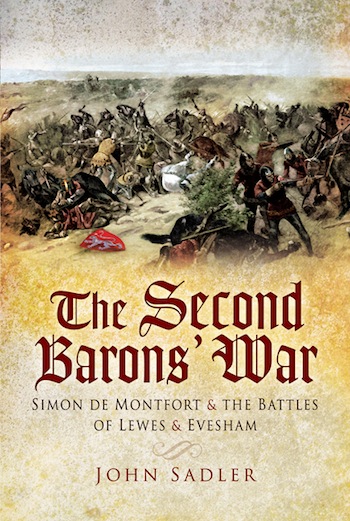
John Sadler
The Second Barons' War:
Simon de Montfort and the Battles of Lewes and Evesham
South Yorkshire: Pen and Sword Books, 2008. 192 pp. £19.99/$39.99. ISBN 978-1844158317.
John Sadler, a lifelong enthusiast of military engagements in northern England as befitting his Northumberland roots, has an impressive list of publications largely focusing on battles and wars between England and Scotland. In an attempt to provide more attention to the civil war of the mid-thirteenth century between royal and baronial factions, which perhaps has unfairly been overshadowed by scholarship devoted to the later Wars of the Roses and English Civil War, Sadler concentrates chiefly on the pivotal campaigns of 1264 and 1265 in The Second Barons' War.
Sadler's book is logically organized along chronological lines. In the first two chapters, the author sets the stage for the meat of the discussion by covering respectively an overview of medieval war, including weapons, armor, strategy and military realities, and a summary of Henry III's reign including the events and political circumstances leading to an eventual military conflict with Simon de Montfort and the other barons. Similarly, the final chapter promises to discuss the legacy of the two battles of Lewes and Evesham, although the chronological scope of that legacy has been disappointingly limited merely to the end of the Barons' War rather than beyond. The intervening four chapters are particularly devoted to close studies of the Lewes and Evesham campaigns, with explanation and analyses of the more strictly strategic and tactical aspects rather than political or contextual causations and implications. Indeed, Sadler is clearly more excited about retelling and investigating the pure military details.
Sadler's work is readable, engaging, and, although perhaps somewhat light on the scholarly aspect, is nonetheless undeniably scholarly. First of all, Sadler does provide proper citations and notes. A fairly extensive "select" bibliography containing a substantial section of primary sources, comprises both current and classic scholarship on the book's main topics of the battles of Lewes and Evesham, and more generally the reigns of Henry III and Edward I including their clashes with de Montfort. The author is clearly comfortable working with chronicle sources, as he both provides an exhaustive list of them in the bibliography, and refers to them often in his text.
Sadler has incorporated some very helpful elements into his book, some of which are of especial assistance to those not familiar either with the important people involved in this political and military struggle, or with the particulars of military formations and tactics. Just after the table of contents, the author has included a detailed timeline of the events of English royal history from Magna Carta in1215 to the death of Henry III and the accession of his son, Edward I in 1272, with understandably expansive details for the years 1264 and 1265. Following this timeline is a seven-page-long list of people important to this conflict, including biographical information, family connections, and even brief histories of each person's attitude toward royal policies (pp. xix-xxv). In chapters three through six, the ones detailing the specifics of the Lewes and Evesham campaigns and actual battles, Sadler has included maps illustrating the paths taken by enemy forces, as well as pictorial depictions of the battles' narrative. The map of the battle of Lewes, for instance, not only provides the routes taken by both the royal and baronial armies to the site of the battle, but also includes an inset map showing the drawn battle lines, formations of the two armies, and course of the battle in which Prince Edward (later Edward I) managed to destroy and disperse the baronial left flank composed of Londoners. (56) Eight glossy pages between the chapters on Lewes and Evesham (between pages 70 and 71) contain black and white photographs of the sites of Lewes and Evesham today. Important landmarks and structures discussed in the text are here brought to life visually. Additionally, Sadler has compiled a short glossary of common medieval military terms that he has used throughout his book. For the novice military historian, the explanation of these specialized terms could be immensely helpful.
Before the scholarly apparatus at the end of the book, Sadler added three appendices, two of which might be useful for the broad audience of the book, although the third has quite a narrow application. The first appendix is essentially an historiographical study that discusses in some detail certain alternative views for an element of the progression of the battle of Evesham. While perhaps it is important for more serious scholars of this battle to be introduced to this historiographical debate, it was wise for Sadler to isolate this discussion in an appendix rather than bog down the momentum of his narrative by incorporating it into the corresponding chapter. The second appendix is more of a travel guide, providing helpful hints for journeying and discerning landmarks should one wish to travel to the battle sites of Lewes and Evesham themselves. The last appendix would appeal to a very narrow readership indeed, as the author has proffered suggestions should one wish to make their gaming experience more true to history when playing one of the strategy war games that deals specifically with these two battles. In some ways the inclusion of this information detracts from the scholarly bent of the book, although it is possible that the appendix might broaden the audience for whom this book would be useful.
In general, Sadler's book is solid and well written even if somewhat narrow of scope. However, it is ideal if one is looking for a good military overview of the two central campaigns of the Second Barons' War, without requiring significant contextualization, background information, or socio-political ramifications.
